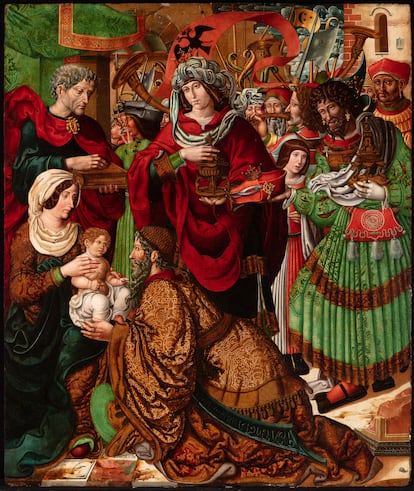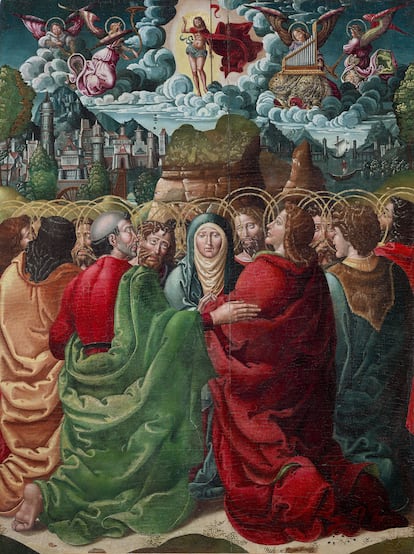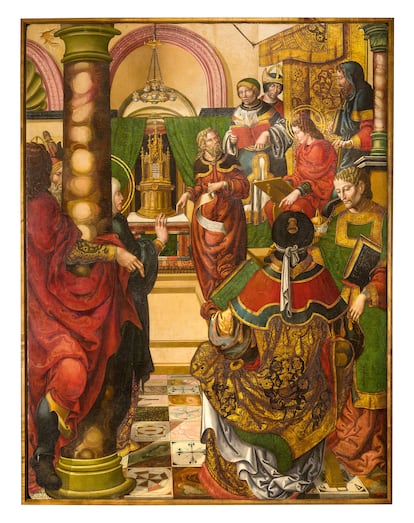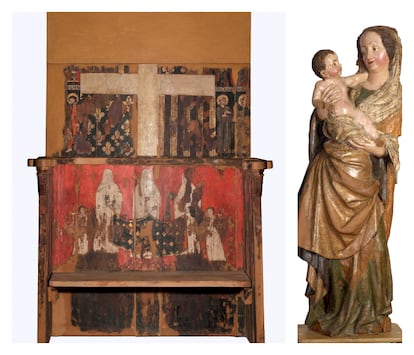The journey through the world of the other works of the Sijena Monastery

The story of how nuns got rid of a large part of the heritage of the Royal Monastery of Sijena, in Huesca, has once again become a fierce cultural, political, and judicial debate between the Government of Aragon, the National Art Museum of Catalonia (MNAC), the National Heritage Council, and the Generalitat (Catalan Government). A Supreme Court ruling on May 28th endorsed the return of the murals exhibited at the MNAC to their place of origin. But these are not the only works that were dispersed from what was a great religious and cultural center since the 12th century. Other pieces from the monastery embarked on different journeys around Spain and around the world from the 19th century until 2018, when the Meadows Museum in Dallas, United States, became one of the last cultural institutions to acquire a painting from the Huesca building.
What is known as the Treasure of Sijena began to disintegrate when the Baroque era erupted in Spain. At that time, the Renaissance style fell out of fashion, and consequently, the monastery's main altarpiece, designed by the so-called Master of Sijena, identified by a notarial document as Rodrigo de Sagonia, between 1515 and 1520, was dismantled to be updated in line with the new Baroque fashion. The panels in this important space were taken down and stored away.
"They probably came out before 1923, when the monastery was declared a national monument," Joaquín Español, the lawyer who handled the case, explained in various interviews. "Many were acquired through third and fourth purchases, so it's not so easy to reclaim them."
This is the journey that Sijena's so-called "other works" made around the world, which, for the moment, are not in legal dispute.
Prado Museum The Nativity
In 2003, the Prado Museum exercised its right of first refusal and acquired the Nativity painting at an auction at the Sala Alcalá (Madrid) for 90,000 euros , according to an official document that the art gallery shared on its Twitter account at the time.
The piece comes from the main altarpiece of the Royal Pantheon of the Monastery of Sijena and was sold by the nuns of San Juan. The exact date of its departure from this center is unknown. In the 18th century, it began a journey that lasted until 2003, when the piece entered the Prado.
In 1926, art historian August Mayer published an article in which he claims that the work was bought by antique dealer A.L. Nicholson, who put it up for sale in London. The next clue appears in 1944. That year, the collector Arnold Seligmann included it in the Great Exhibition of World Famous Paintings in the Salons of Galerías Ordáz , in Mexico City. After that sale, it appeared in Madrid.
The Prado piece, which shows the Holy Family with the child lying on the ground, is attributed to the Master of Sijena, who resided at the monastery at the time this painting was made, according to a notarial document. The panel is currently on display. “It is part of a discourse that seeks to illustrate the artistic movements in the Iberian Peninsula from the 15th century and early 16th century,” explains Joan Molina, head of the European Painting Collection up to 1500. “It is a period marked by a great heterogeneity of models and aesthetic proposals coming from Italy and France, and in the case of Sijena, from various areas of the Germanic Empire.”
“The Master of Sijena is a very interesting figure because he is Gothic and incorporates many elements of the Italian Renewal,” Molina notes, emphasizing the importance of what he calls “a hybrid style” in this period of art history in Spain. “As a collection, they allow us to explain how the boundaries of art history were weak, almost nonexistent, even though we sometimes insist on creating categories and models that end up being false.”
Meadows Museum in Dallas The Adoration of the Magi
In 2018, the Meadows Museum in Dallas purchased the panel The Adoration of the Magi, which belonged to the monastery's main altarpiece, from the Caylus gallery , a specialist in ancient art. Neither then nor now, in response to questions from EL PAÍS, did the institution or Enrique Gutiérrez de Calderón, the antique dealer's director, confirm the purchase price, which various reports published the year of the sale put at around half a million euros.
The panel left the monastery before 1908, or at least that's the version its various owners have given over the years. The date is far from 1923, a key year because that was when the site was declared a heritage site and its works were protected.
The piece crossed the Spanish border in 1917. Caylus acquired it in 2017 at an auction in Geneva, from a Swiss collection. At that sale, the panel was cataloged as "from the 16th-century Italian school," with no other details that might have caught the attention of institutions such as those in Aragon and Catalonia at the time. The Madrid gallery paid more than €100,000 for the work, according to various reports published at the time, and was in charge of the restoration process. Thanks to permits obtained from the Qualification Board of the Ministry of Culture, The Adoration was exhibited at the Frieze Art Fair in London and at Tefaf in New York.
“We bought it because it represents an aspect of artistic production in Spain that we didn't have in the museum,” explains Amanda Dotseth, director of the Meadows Museum in Dallas, “we don't have that much work made before the 16th century.” She also emphasizes that this piece features an important detail in its iconography: “The possible 'idealized portrait' of Charles V.”
The work is displayed in a large room dedicated to the 15th and 16th centuries, featuring pieces from the Meadows' permanent collection and long-term loans from the Museum of Fine Arts, Boston. In this space, Sijena's panel interacts with works by Martín de Soria, Juan de Borgoña, Yánez de la Almedina, Francisco Gallego, and Domingo Ram.
Huesca Museum: The four panels from the Valentín Carderera collection Panel 'Embrace at the Golden Gate', from the altarpiece of the Sijena Monastery. Courtesy: Huesca Museum.
Panel 'Embrace at the Golden Gate', from the altarpiece of the Sijena Monastery. Courtesy: Huesca Museum.  The Birth of the Virgin panel, from the altarpiece of the Sijena Monastery. Courtesy: Huesca Museum.
The Birth of the Virgin panel, from the altarpiece of the Sijena Monastery. Courtesy: Huesca Museum.  Panel 'The Annunciation', from the altarpiece of the Monastery of Sijena. Courtesy: Huesca Museum.
Panel 'The Annunciation', from the altarpiece of the Monastery of Sijena. Courtesy: Huesca Museum.  Panel 'The Visitation', from the altarpiece of the Monastery of Sijena. Courtesy: Huesca Museum.
Panel 'The Visitation', from the altarpiece of the Monastery of Sijena. Courtesy: Huesca Museum.Embrace at the Golden Gate, The Birth of the Virgin, The Annunciation , and The Visitation are the four panels that the collector and painter Valentín Carderera acquired from the nuns of the Sijena Monastery after the Renaissance altarpiece was dismantled. The pieces arrived in Huesca in 1873 and, along with other works from the artist's collection, formed the basis for the city museum.
“The works are permanently displayed in the museum chapel because this institution is the seat of the Old Royal Family and the former University,” says Fernando Sarria, head of the Archives, Museums, and Libraries service at the Directorate General of Culture of Aragon. “With these pieces, we can illustrate the early Renaissance in Aragon,” explains the former director of the Huesca Museum. “It's a period that, due to the stylistic changes of the time, was dispersed like the panels in the Monastery.”
Museum of the Holy Cross of Toledo The Presentation of the Virgin in the Temple and The Ascension
The two paintings in this museum were purchased in May 1959 from Lord Robert Crichton Stuart in London, pursuant to an order from the then Ministry of National Education, and arrived at their current destination that same year . These panels also come from the main altarpiece, but, according to Antonio Francisco Davila, director of the Toledo institution, "their journey until their purchase in London is unknown."
Nor, the manager states, "can we determine the date they left the monastery. Press articles indicate it was before 1923, and the museum's former director suggests the 19th century as the most likely date. There are no documents in the museum's archives that provide reliable information on this matter." It is only known that before entering this center, the works passed through the Royal Academy of Fine Arts of San Fernando.
"These panels belong to the artistic period that ran from the late 15th century to the mid-17th century, especially in its religious aspect, the style best represented in the Santa Cruz Museum," Davila continues. "They are two representative works of Central European Renaissance painting, with features that connect them with the Flemish school, so popular in Castile at the time, a style that powerfully influenced Spanish Renaissance painting in general and that produced in Toledo throughout the 16th century in particular."
At this time, the two pieces are not on display due to ongoing work at the Toledo Museum. However, at other times, they have been exhibited alongside works by Juan de Borgoña, Juan Correa de Vivar, and Francisco de Comontes, as well as Flemish and other European painters such as Pieter Coecke Van Aelst and Nicolás Francés.
Lleida Museum Six pieces
The early hours of December 11, 2017, will remain etched in the memory of the Lleida Museum staff as the cold and rainy night when 44 pieces from the Sijena Monastery left this institution on their way to Huesca by court order. Just after 4:00 a.m., a large force of Mossos d'Esquadra (more than 100 officers and nearly a dozen vans) cleared the entire area around the museum of the 100 people who had gathered there at that time. Inventory and packing work were carried out in the temporary exhibition area. Afterward, the works, which the Generalitat (Catalan government) purchased from the nuns for 10 million pesetas and deposited at this museum, left for their new home.
This is an account of the chronicles of that night, because almost a decade later it's hard for anyone to want to talk about what happened.
Just when it seemed that all the attention was focused on the MNAC, in mid-June, Alberto Velasco, director of the Lleida Museum, announced his resignation due to what he considered an "unworthy and reprehensible position of the Generalitat (Catalan Government), the museum's owner, in the case of the Sijena paintings. The academic defends the same position as that of the MNAC's curators and that endorsed by all the museum's patrons—including the Generalitat (Catalan Government), the Ministry of Culture, and Barcelona City Council: dismantling the reconstruction of the old murals (barely 65% of the total is original), transporting them to Aragon, and placing them in a room where the current environmental conditions are modified cannot be done "without putting them at risk."

Of the objects that were deposited in 1970 and finally acquired by the Generalitat in 1983, six remain, according to the inventory of the Lleida Museum to which EL PAÍS has had access: the priory throne of Blanca de Aragón y Anjou; Marededéu (polychrome wood); Santa Eulàlia and Santa Madrona / Santa Llúcia i Santa Àgueda (polychrome wood); the panel Jesus among the doctors by Rodrigo de Sajonia; Sant Pere / Sant Pau / Sant Ambròs / Sant Agustí by Rodrigo de Sajonia (polychrome wood); and the altarpiece of the Immaculate Conception with the predella.
One of the panels belonged to the businessman Matías Muntadas, whose collection also experienced its own peculiar journey after being confiscated at the beginning of the Civil War: it traveled from Barcelona to Olot, Darnius and Geneva and was later recovered by his relatives until the late 1950s.
Format: Brenda Valverde Rubio
Design: Ana Fernández
Development: Carlos Muñoz
EL PAÍS





%3Aformat(jpg)%3Aquality(99)%3Awatermark(f.elconfidencial.com%2Ffile%2Fbae%2Feea%2Ffde%2Fbaeeeafde1b3229287b0c008f7602058.png%2C0%2C275%2C1)%2Ff.elconfidencial.com%2Foriginal%2Fbd2%2Fe90%2F7a5%2Fbd2e907a569ebeebd9fc42bee4511ddc.jpg&w=3840&q=100)